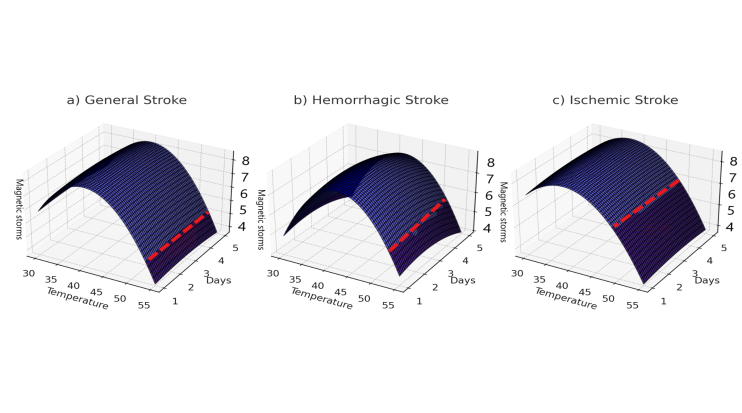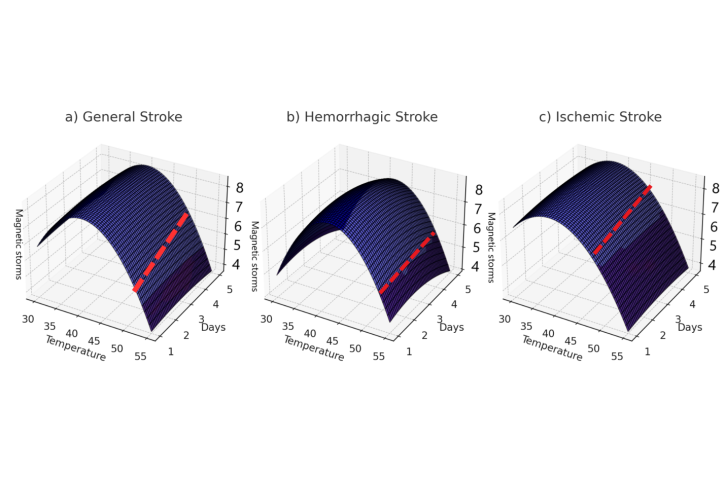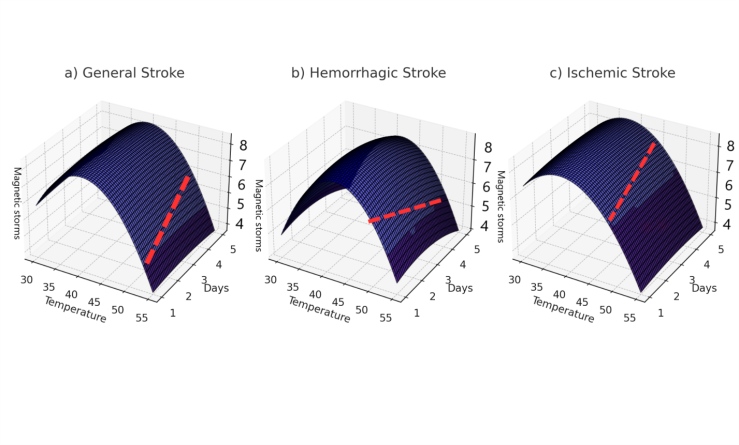-
Paper Information
- Next Paper
- Paper Submission
-
Journal Information
- About This Journal
- Editorial Board
- Current Issue
- Archive
- Author Guidelines
- Contact Us
American Journal of Medicine and Medical Sciences
p-ISSN: 2165-901X e-ISSN: 2165-9036
2025; 15(3): 491-495
doi:10.5923/j.ajmms.20251503.01
Received: Jan. 22, 2025; Accepted: Feb. 17, 2025; Published: Mar. 5, 2025

Combined Influence of High Temperature and Magnetic Storm on the Development of Strokes in the Aral Sea Region
Khudaybergenov N. Y., Adambaev Z. I., Kilichev I. A., Niyazmetov M. R.
Urgench Branch of the Tashkent Medical Academy, Urgench, Uzbekistan
Copyright © 2025 The Author(s). Published by Scientific & Academic Publishing.
This work is licensed under the Creative Commons Attribution International License (CC BY).
http://creativecommons.org/licenses/by/4.0/

The aim of the study was to investigate the effect of high temperature and magnetic storms on the development of stroke in the Aral Sea region using the Khorezm region as an example. Medical records of patients with stroke (n = 897) were analyzed. The regional air temperature and geomagnetic activity were determined. Study have shown that the risk of stroke (especially ischemic stroke) increases significantly when the daily temperature exceeds 30°C and the magnetic storm index is within 4-8 points. In patients with pre-stroke cerebrovascular disorder, the combined effects of air temperature above 30°C (in men - above 35°C) and magnetic storm of magnitude 4 cause the development of ischemic stroke, and a combination of high temperature above 40°C and magnetic storm of magnitude 5-6 points cause the development of hemorrhagic stroke.
Keywords: Stroke, Acute cerebrovascular accident, High air temperature, Magnetic storms, Autonomic stress reactions, Weather dependence, Aral Sea region
Cite this paper: Khudaybergenov N. Y., Adambaev Z. I., Kilichev I. A., Niyazmetov M. R., Combined Influence of High Temperature and Magnetic Storm on the Development of Strokes in the Aral Sea Region, American Journal of Medicine and Medical Sciences, Vol. 15 No. 3, 2025, pp. 491-495. doi: 10.5923/j.ajmms.20251503.01.
Article Outline
1. Introduction
- According to the latest data from the World Health Organization (WHO), vascular diseases of the brain are the second leading cause of death from diseases of the cardiovascular system. This has made cerebrovascular diseases a serious social problem, which the WHO has declared a global epidemic [1,2]. Along with common risk factors like high blood pressure, atherosclerosis, diabetes, and bad habits, weather conditions (such as temperature, humidity, solar and geomagnetic activity (GMA)), and bad environmental conditions are becoming more and more important in the development and occurrence of this disease [1,11,13,14,18,21].In recent decades, climate changes have resulted from alterations in the planet's natural environment, including variations in atmospheric thermal balance, oceanic circulation, the hydrological cycle, solar oscillations, and both cosmic and anthropogenic influences. These changes have a negative impact on people's health. The consequences of global warming are discussed, due to which there is an increase in the frequency of extreme weather events in the form of extreme temperatures and magnetic storms, which negatively affect human health [12,16].According to various studies, geomagnetic storms were associated with an increased risk of stroke from 19% to 52%, depending on the severity of the geomagnetic storm [15], and a positive correlation was also found between the frequency of geomagnetic storms and mortality from common cardiovascular diseases [13,22].Even though there are a lot of publications, they often say different things. Up to this day, no one has figured out if and how extreme temperatures and magnetic storms affect people, or how to protect patients who might be at risk from these potentially harmful effects.The Khorezm region is located in the northwestern part of Uzbekistan. The Khorezm oasis is surrounded by the huge, dry deserts of Karakum and Kyzylkum. These deserts are a big part of how air masses that come in from the west, northwest, and sometimes the northeast change quickly [3,7]. An area of slightly low pressure (thermal depression) forms over the highly heated desert spaces of the Turan Lowland during the warm period. Extreme air temperatures during the development of thermal depression in the central desert regions reach 45-49°C. The soil surface heats up to 70°C and above. Significant variability of air temperature from winter to summer, and during the summer period during the day, is one of the main manifestations of the sharp continental climate [19].Summer thermal depression occurs after a cold invasion during the transformation of air masses and lasts for weeks. Thermal depression is one of the most important climate-forming factors. This synoptic position is characterized by a cloudless sky, dusty haze, very high air temperatures (up to 30°C and above in the morning and 40–43°C in the afternoon), and extremely low relative humidity, which often does not exceed 10%. Low atmospheric pressure in the aboveground layers of the troposphere is also characteristic sign (1,66). As a result of the “Register of Brain Stroke” in the Khorezm region for 2019, it was revealed: a predominance of strokes in men (54.9%) over women (45.1%); the incidence of stroke also prevailed in men (347.69 per 1000 population) over the incidence in women (247.12 per 1000 population); mortality from stroke also prevailed in men (137 per 100 000 population) over mortality in women (98.6 per 100 000 population); mortality from stroke also prevailed in men (36%) over mortality in women (34.2%) [4,5,6,7,9,10,17,19]. All of the above information determined the purpose of our present study.The purpose of the study is to examine the influence of high temperatures and geomagnetic storms on the development of cerebral strokes in the Aral Sea region, using the example of the Khorezm region.
2. Material and Research Methodology
- We analyzed the inpatient records of stroke patients (n = 897) treated in neurological departments of the Khorezm region for 2023. Of these, there were 452 men and 455 women. The average age of the patients was 60.8±0.3 years, for men -60.03±0.5 years, and for women, 61.6±0.4 years.When studying the structure of strokes in patients, the ratio of ischemic stroke (IS) to hemorrhagic stroke (HS) was found to be 4:1. In men, this ratio was 3.8:1, due to a slight excess of HS, and in women, it was 4.3:1, due to more prevalence of IS (Table 1).
|
3. Research Results
- Studies have shown that going to the emergency room for a stroke goes up a lot when the daily high temperature is above 30°C and the magnetic storm index is between 4 and 8 points. This is especially true for ischemic strokes. According to the study, the frequency of days with temperatures above 30°C averaged 50.6±12.0 days in 2023. Throughout 2023, the GMA was analyzed by month: of which, January, June, July, August, and October were the months with low GMA - the average daily GMA was 2.03 points; February, March, April, May, September, November, and December were the months with high GMA - the average daily GMA was 2.33 points.A linear increase in ischemic stroke with an increase in air temperature and GMA was revealed - from 10.8% at 40°C and GMA 6 points to 40.06% at 45°C and GMA 8 points.In Figure 1a, the graph showing the effect of temperature and the intensity of magnetic storms on the development of strokes in all patients is presented. When the magnetic storm index is 4 points and the air temperature exceeds 30°C, the risk of a general stroke starts to increase from the first and second days and reaches 35%. The second peak of strokes occurs on the 4th day after geomagnetic disturbances and when the air temperature exceeds 30°C, with the probability of a stroke reaching up to 80%. Splines of multivariate adaptive regression for stroke estimation were calculated using component concentrations.In Figure 1b, the graph shows the effect of temperature and the intensity of magnetic storms on the development of hemorrhagic strokes in all patients. When the magnetic storm index is 5-6 points and the air temperature exceeds 40°C, the risk of hemorrhagic stroke begins to rise from the first and second days and reaches 25%. The second peak of strokes occurs on the 4th day after geomagnetic disturbances and when the air temperature exceeds 30°C, with the probability of a stroke reaching up to 80%. Splines of multivariate adaptive regression for stroke estimation were calculated using component concentrations.In Figure 1c, the graph shows the effect of temperature and the intensity of magnetic storms on the development of ischemic strokes in all patients. When the magnetic storm index is 4 points and the air temperature exceeds 30°C, the risk of a general stroke starts to increase from the second day and reaches 25%. The second peak of strokes occurs on the 4th-5th day after geomagnetic disturbances and when the air temperature exceeds 30°C, with the probability of a stroke reaching up to 80%. Splines of multivariate adaptive regression for stroke estimation were calculated using component concentrations.
 | Figure 1. The effect of temperature and the intensity of magnetic storms on the development of strokes in all patients |
 | Figure 2. The effect of temperature and the intensity of magnetic storms on the development of all types of strokes in men |
 | Figure 3. The effect of temperature and the intensity of magnetic storms on the development of all types of strokes in women |
4. Discussion
- The results of our research suggest that the combined effect of high air temperatures (above 30°C) and magnetic storms (with magnitudes of 4-8 points) can be considered a risk factor for the development of strokes in patients with pre-stroke conditions in the Aral Sea region. The triggering effect of this combined risk factor on the development of strokes is likely mediated through the activation of non-specific pathogenic mechanisms in patients predisposed to stroke, primarily in the form of a stress reaction, which in turn induces the activation of specific pathophysiological mechanisms for the development of acute cerebrovascular accidents (CVA) [15]. In light of the growing threat of cerebrovascular diseases, scientists are paying attention to the possible mechanisms of the relationship between meteorological factors and the development of stroke. However, a deeper understanding of the pathogenesis of the combined effects of high temperatures and magnetic storms on the development of ischemic and hemorrhagic strokes requires further in-depth research [1].High temperature, reaching critical levels, can lead to overheating of the body and deterioration of the cardiovascular system. Sudden temperature fluctuations can provoke vasospasms, which in turn increases the risk of thrombosis [8]. At the same time, magnetic storms, which affect biochemical processes in the body, can trigger changes in blood pressure and impair blood coagulation [1,2,11]. In addition, social factors such as stress levels and adaptation to climate changes also have a significant impact on public health. Studies show that during extreme weather conditions, people's emotional states deteriorate, which may lead to exacerbations of chronic diseases and increased susceptibility to strokes [1]. Given the specific nature of the region, it is important to note that patients aged 50-65 are at the highest risk of stroke under extreme temperatures and magnetic storms.In this context, it is crucial to consider the role of education and public awareness regarding the negative consequences of climate change, as well as methods to minimize their impact on health. Therefore, specialized medical programs aimed at supporting this population are necessary. Additionally, there is a lack of information in the Aral Sea region about potential risks related to climate change. Public awareness campaigns about the importance of adapting to changing weather conditions can play a key role in preventing strokes.Thus, the combination of these factors creates potentially dangerous conditions for patients, especially those already predisposed to stroke. Equally important is the development of local strategies that include strengthening the monitoring of magnetic storms and temperatures. This will enable timely communication with the public about the onset of hazardous weather conditions and recommend appropriate precautionary measures.
5. Conclusions
- 1. In patients with pre-stroke cerebrovascular disorders in the Aral Sea region, the combined effect of air temperatures above 30°C (for men, above 35°C) and magnetic storms with a magnitude of 4 points leads to the development of ischemic strokes. The combination of high temperatures exceeding 40°C and magnetic storms with a magnitude of 5-6 points leads to the development of hemorrhagic strokes.2. It makes sense to highlight as a separate combined risk factor, acting as a trigger for stroke development, the combination of air temperatures above 30°C and magnetic storms with a magnitude of 4-8 points.3. On days with elevated air temperatures and magnetic storms, preventive measures should be implemented for patients with risk factors for stroke development.
ACKNOWLEDGEMENTS
- The authors express their gratitude to the staff of the Department of Neurology, Psychiatry, and Medical Psychology at the Urgench branch of the Tashkent Medical Academy for their assistance in patient selection; to Professor Z.I. Adambaev of TMA for writing the article; and to Professor I.A.Kilichev of TMA for editing the article. The authors declare that they have no conflict of interest in writing this article. The work was carried out as part of the dissertation project. The research was funded with personal resources.
 Abstract
Abstract Reference
Reference Full-Text PDF
Full-Text PDF Full-text HTML
Full-text HTML